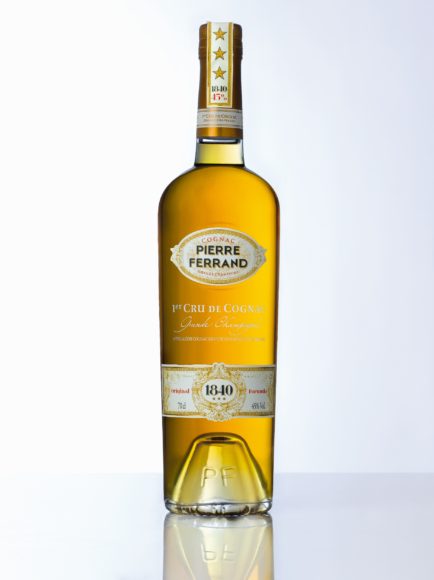By Seánan Forbes

A product of passion, tradition and collaboration, Pierre Ferrand’s new-old Cognac – the 1840 – is built for industry.
More and more, bars and restaurants take pride in serving classic cocktails. That requires pouring the right spirit in the glass. As Ferrand Vice President Guilaume Lamy observes, “Cognac was the base for mixing in the nineteenth century.”
It pays to know your history. These days, customers do – and they expect the highest quality ingredients from the bar as well as the kitchen, with respect for source and tradition.
So it was a perfect time for Ferrand to dip into the past and reproduce a period cognac. For Ferrand, Lamy says, “this is a historical thing to do: to reconstruct a cognac that was drunk back in 1840.”
Alexandre Gabriel, Ferrand’s owner, didn’t work alone. In a different kind of spirit – one of international creativity – he invited a friend, American author-historian David Wondrich, to join the project. Wondrich remembers the call. Gabriel said, “I’ve got this project you might be interested in . . .” Bringing history alive? There’s not a drop of doubt.
According to Lamy, Wondrich’s input was vital. “Alexandre is very knowledgeable about taste. For history, David is the expert.” Of course, history is an integral component of Ferrand 1840 Original Formula Cognac.(www.pierreferrandcognac.com)
The experts worked with rare materials. “Alexandre rounded up bottles of drinking-grade Cognac from back in the day – hard to find,” Wondrich remarks, “because people tended not to keep them.”
Gabriel sourced a remarkable selection: approximately fifty bottles of nineteenth century cognac. “Some were very bad,” Lamy notes, “oxidized or tasted like cork, and some were wonderful.” “The 1840,” Wondrich says, “was fantastic.” In fact, it was everybody’s immediate first choice.”
That choice was but the beginning. “The big difference between 1840 and 2011,” Lamy says happily, “is that we have technology.” Chromatography analyzes complex mixtures. “We saw the elements in the spirit that would make that taste – and we reproduced it.” To recreate the spirit, Lamy says, Ferrand “used old nineteenth century techniques not used today.”
The 1840 is “a three-star, which is a younger version of an amber – an old equivalent of a high-end VS.” It has “higher dosage” and “a similar flavor to demi-glace in cooking.”
Consider it a gift. “This is a product we made for mixologists.”
More precisely, it is a cognac made for pre-Prohibition cocktails. It doesn’t get more authentic than this. Lamy says, “This is what was used for Sazeracs and juleps,” back in the day.
If you have patrons who are keen on tradition, then you have a market for old-school cognac cocktails. With any curious customer, use Wondrich’s knowledge to encourage them to try cognac as a mixer. “In the nineteenth century, cognac would be number one, Dutch gin number two, whisky number three.” That’s generic.
About Pierre Ferrand 1840 Original Formula Cognac in particular: “It’s great in cocktails. It’s 90 proof, a little more concentrated . . . It’s got some great blending tricks of its own.” Built in an era where cognac meant cocktails, this is a resilient spirit that holds its own in a mix.
Don’t think that cognac cocktails are just a coastal big-city phenomenon. Italy-born Mauro Mahjoub has been making drinks since 1989. In addition to his successful Mauro’s Negroni Club in Munich (www.maurosnegroniclub.de/Mauros_Negroni/NEGRONI_Club.html) he also teaches cocktail-making and history. Mahjoub likes putting cognac in its proper historical place: in cocktails. On a hot afternoon in Cognac, people queue for Sazeracs, juleps and sidecars.
In cognac’s hometown, the spirit’s enjoyed with ginger ale, sweetened with macerated fruit, spiced with sliced jalapeno…Tradition is venerated, but bartenders aren’t loath to take the spirit to a lighter side.
If you’re new to experimenting with cognac, then Ferrand 1840 Original Formula Cognac is a friendly substance. You might set your bartenders a challenge of creating a new hot-weather sparkler with 1840 as a base, mixing the old and the new.
For reliable marketing, though, you can’t go wrong with the classics. Looking for an easy summer seller? “For me, there’s nothing better than a Cognac mint julep,” Wondrich says. “Cognac, sugar and mint – and lots and lots of shaved ice. You can float rum on top.” Rum? Really? “Rum and cognac is a wonderful combination.” Wondrich recommends trying cognac with dark Jamaican rum.
That’s the kind of twist that sells.

